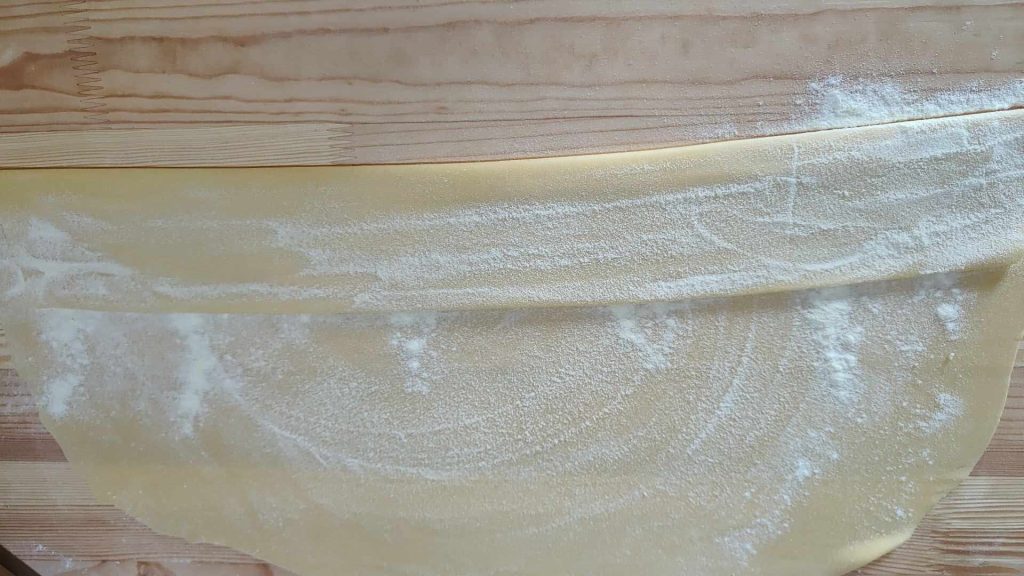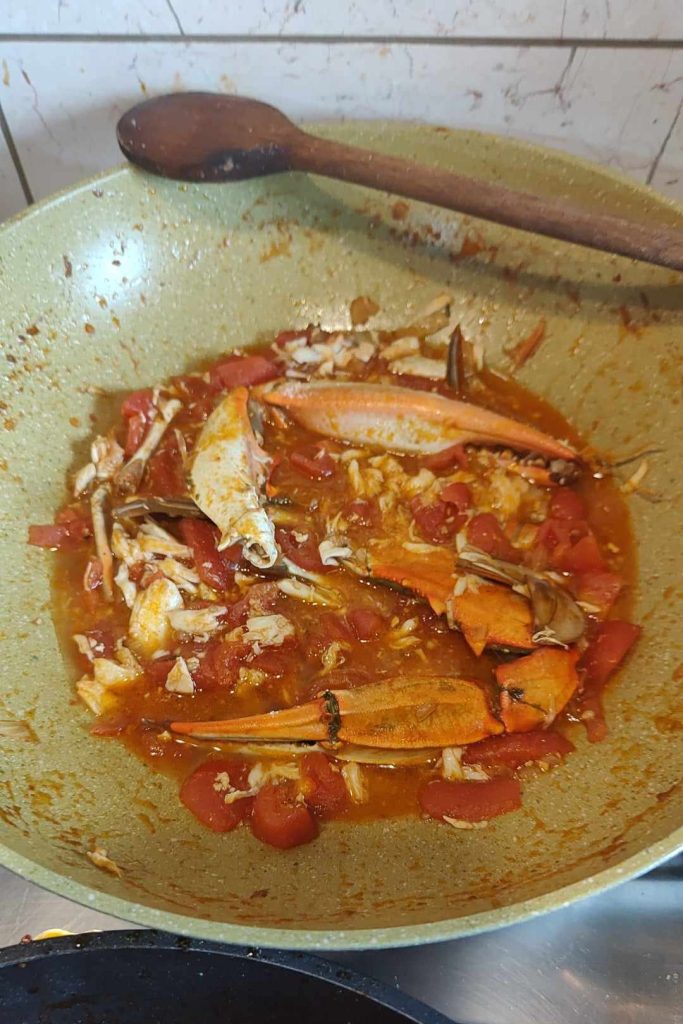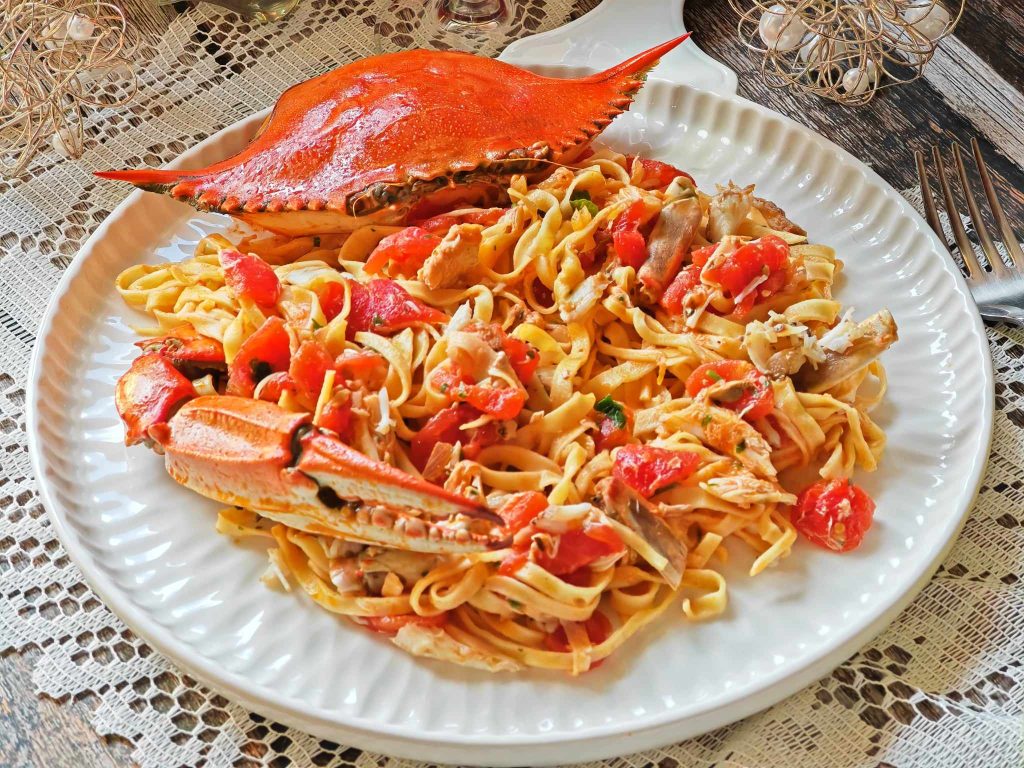Tagliolini with fresh crab is a refined and exquisite seafood dish made with fresh crab for maximum flavor.
Yesterday, I went downtown for errands and saw the fresh fish stand with blue crab on sale. I was intrigued by what I heard on TV, so I thought, why not try it.
I must be honest, it’s delicious with a wonderful taste.
The tagliolini with crab recipe is not difficult, just requires some patience to extract the meat, and you’re done.
I brought a pot of water to a boil and let the crabs in for ten minutes, during which they change color from brown/blue to red.
After removing the crabs and while they cooled, I chopped the cherry tomatoes and onion finely, took a pan, added some EVO oil, and let the onion brown. Then I added the cherry tomatoes and covered it with a lid.
Armed with patience, I cleaned the blue crabs by removing the meat and setting it aside.
I placed the crab shells and claws whole to further flavor the sauce.
This first course has an intense aroma and flavor and is also very scenic when served with the shell of the crustacean.
For the pasta, I preferred to knead the tagliolini by hand. Of course, spaghetti or linguine will do as well, as you prefer, but homemade pasta is more porous and absorbs the sauce well.
As you know, I love getting my hands in the flour, and my passion has led me to start a fresh pasta group on Facebook, and so I feel more involved than usual; I would knead all the time.
These handmade tagliolini are really simple to make and suitable for many sauces, both meat and seafood.
It may seem like a long recipe, but it’s not; it takes about an hour, but it’s definitely worth it, and it’s certainly an economical recipe!
The recipe for this crab pasta is not difficult, just requires some patience to extract the meat, and you’re done.
Follow my tutorial, and tagliolini will no longer be a mystery for you!

- Difficulty: Easy
- Cost: Economical
- Rest time: 30 Minutes
- Preparation time: 1 Hour
- Portions: 4/6
- Cooking methods: Stove
- Cuisine: Italian
- Seasonality: All seasons
- Energy 373.04 (Kcal)
- Carbohydrates 50.92 (g) of which sugars 4.49 (g)
- Proteins 17.78 (g)
- Fat 10.79 (g) of which saturated 2.68 (g)of which unsaturated 2.59 (g)
- Fibers 2.83 (g)
- Sodium 781.66 (mg)
Indicative values for a portion of 5 g processed in an automated way starting from the nutritional information available on the CREA* and FoodData Central** databases. It is not food and / or nutritional advice.
* CREATES Food and Nutrition Research Center: https://www.crea.gov.it/alimenti-e-nutrizione https://www.alimentinutrizione.it ** U.S. Department of Agriculture, Agricultural Research Service. FoodData Central, 2019. https://fdc.nal.usda.gov
Ingredients for Tagliolini with Crab
- 14 oz all-purpose flour
- 4 eggs (medium)
- 1 pinch salt
- 3 crabs (medium or two large)
- 12 oz cherry tomatoes
- Half glass dry white wine
- 1 shallot
- 1 clove garlic
- salt
- pepper
- to taste extra virgin olive oil
- chopped parsley
- 2 leaves bay leaf (for blanching the crab)
Tools
- Kneading Board
- Rolling Pin
- Kitchen Scale
- Pan
- Pot
Steps for Tagliolini with Crab
To prepare fresh egg pasta, it is ideal to knead the ingredients on a wooden board or kneading board. Pour the flour on the board and create a wide well in the center.
Break the eggs into the well and beat them with a fork, gathering the flour from the edges. Gradually incorporate the flour to make the dough denser.
Be careful not to let the eggs spill out of the edges.
When you can’t incorporate the flour any longer, start kneading by hand.
Work the dough vigorously until you get a smooth and firm consistency.

Place the dough in a bowl, cover it with plastic wrap, and let it rest for at least half an hour.
The rest is crucial to prevent the pasta from contracting during rolling.
After this time, take the dough, press it with your hands to flatten it, and roll it out with a rolling pin on a floured board. Work the dough until it becomes as thin as you desire.
Run the rolling pin from the center of the dough towards the edges to stretch it and make it even thinner. To help, you can hold the pasta with your other hand as you press.
Rotate the pasta occasionally to stretch it in all directions. If needed, you can lift it from the work surface: roll the dough onto a rolling pin and then lift it.

Once the sheet is ready, generously flour the surface and then roll the dough on itself. Cut the roll into thin slices.

Fill a pot with water, add a moderate amount of salt, bring to a boil, add a few peppercorns and two bay leaves.
Boil the blue crab for 10-15 minutes, depending on size, after the water returns to a boil.
Stir the crab a few times to move the foam that forms.
After the necessary time, remove the crab from the water and let it cool.Once the crabs are cool enough to handle, start by uncovering the shell with your hands and, using a small knife, remove the fibrous and inedible gills.
Split the animal’s body in half and, still using the small pointed knife, remove the meat. Most of what we are interested in is contained in the ventral part of the crab where the various limbs are attached.
Be careful not to make fragments of the shell, which would inevitably spoil the pleasure if they end up in the meat.
With the help of a nutcracker and the inevitable knife, proceed to extract the meat from the individual limbs.
Most of the meat is obviously in the claws, but the other legs should not be neglected either.
One way to extract the meat well is to cut each segment of the legs at the high portion and squeeze out the meat.

Finely chop the shallot and garlic.
Wash the cherry tomatoes and quarter them.
In a large non-stick pan, wilt the chopped mixture with the oil over low heat for 4-5 minutes.
Detach the claws, extract the meat from the carcass, and transfer them to the pan with the aromas and prepared cherry tomatoes.
(Some claws are kept whole to decorate the dishes).
Raise the heat and deglaze with wine, then continue cooking over low heat for about 10 minutes. Add the cherry tomatoes, increase the heat and sauté them for about 1 minute, seasoning with salt and pepper, then continue cooking over low heat for another 4-5 minutes.
Turn off the heat, add a bit of chopped parsley, and mix.

Meanwhile, boil the pasta in plenty of salted boiling water; drain it al dente and pour it into the pan with the sauce, which you have reheated over high heat.
(Tagliolini require a short cooking time).
Sauté the tagliolini for a few seconds so they absorb the flavors well, then serve.

Bon appétit.

Tips
Tips
Cook only live crabs, which means discarding all dead or cracked shell specimens.
Before cooking, store the crabs for short periods in a cool and humid environment, around 50°F, in a breathable container like a paper bag or cardboard box.
Do not store crabs directly on ice or in water, as this will kill them.
To prevent bacterial contamination (bacteria, viruses, or parasites can be found in crabs), wear gloves during handling, use tweezers and keep raw and cooked specimens separate.
Wash your hands frequently and clean work surfaces.
Cook the shellfish thoroughly before eating.
Once cooked, blue crabs have a bright red shell, and the flesh is no longer translucent.
If you liked this recipe, click on many stars, thank you very much.
See you in my group: https://www.facebook.com/groups/488624465780860
or on my page: https://www.facebook.com/gustoamoreefantasie
FAQ (Questions and Answers)
What does it taste like?
A delicate and sweet flavor, similar to that of common crab or shrimp. The meat is tender, juicy, and comes off the shell easily. Blue crab also has an intense and pleasant aroma, reminiscent of the sea.
Can I use canned or frozen crab meat?
Yes, certainly.

